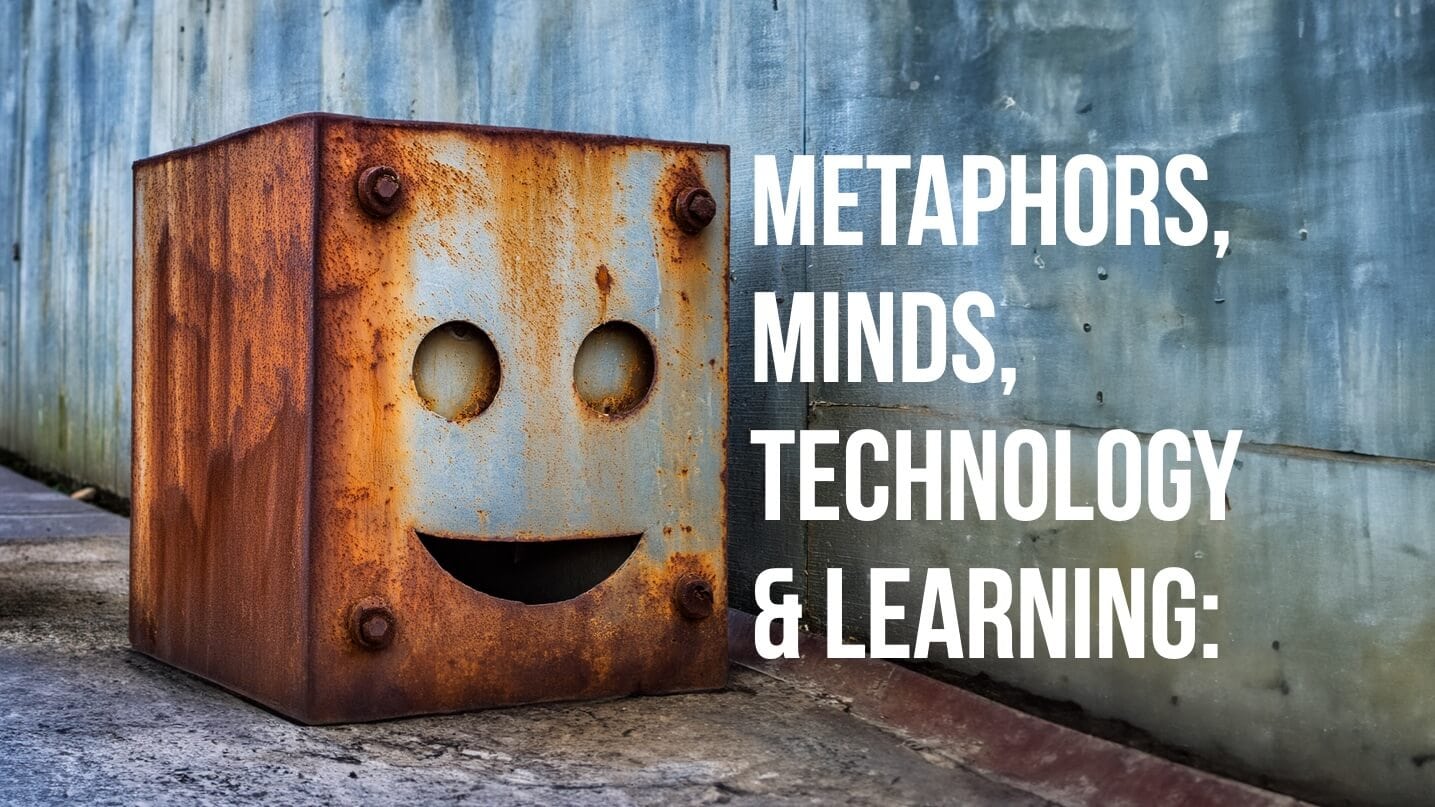Note: The shared blogging experiment with Melissa Warr and Nicole Oster continues. This time we delve into metaphors of the mind, technology and generative AI. The core idea and first draft came from Melissa, to which I contributed a substantial rewrite. The final version emerged through a collaborative process between all three. Finally, the featured image above was created with Adobe Firefly and Photoshop. Final composition and design in Keynote.
Metaphors are fundamental to how we understand the world. Metaphors extend our understanding beyond the concrete and tangible to more abstract and complex ideas, emotions, and phenomena.
Metaphors quite literally transfer meaning, from one (familiar) context to another (unfamiliar context). In fact the word metaphor comes from the Greek, meaning ‘to carry across or beyond‘ (combining ‘meta’ (beyond) and ‘phero’ (to carry).
It is no surprise therefore that trucks in Greece are called Metaphors.

Our language is riddled with metaphors, often hidden from us due to their ubiquity. For instance, it seems quite natural to speak of the “foundation” of an argument, or the “flow” of time. But an argument is not a building, nor is time a river. These are metaphors, albeit ones that have become so naturalized that we don’t see them as being metaphors any more. Metaphors lurk everywhere, not that metaphors can lurk, but you know what I mean.
Our thinking is inherently reliant on such metaphorical mappings.
These metaphorical mappings cut both ways. At one level metaphors provide us ways of understanding something unfamiliar by mapping it to something familiar. But they also constrain us by restricting our thinking and our vision to what we already know. We stop questioning them and they take on an air of finality, providing a simulacra of understanding.
A prime example is when we speak of the mind itself. The mind is essentially an impenetrable black box, its inner workings not available for examination. We, therefore, have no choice but to use metaphorical language to explain the mind. These metaphors, in turn, frame how we can think about the mind and the world. For instance, in an educational context, the metaphors we use for the mind “determine” the kinds of approaches we believe are appropriate for learning and education. This is evident in the variety of learning theories, such as behaviorism, cognitivism, and connectivism, which not only present different theories on how we learn but also embody different definitions of what learning is—each evoking different paradigms and metaphorical understandings.
Technology has an important role to play in determining the metaphors we use for our minds. It has been argued that we often use the latest technology as a metaphor for explaining how our minds work.
In ancient times, when the mind was likened to clay tablets, the language of inscription and permanence might have influenced discussions on memory and knowledge. The invention of clocks, steam engines, and mechanical looms during the Industrial Revolution brought about a variety of mechanistic metaphors which we then applied to explain how minds work. For instance, when we say that “his thoughts get derailed easily” or we speak of “one could see her gears turn in her head” we are assuming that the mind is akin to a machine. And this industrial flavor enters our discussions of education as well, where learners can be seen as “cogs in the machine.”
The early 20th century’s telegraph and telephone systems introduced the idea of connectivity and communication networks, leading to learning theories that emphasize making connections. The rise of computers in the 1950s and the internet in the late 20th century further expanded our linguistic repertoire with terms like “hardwired” for ingrained habits or “downloading” for absorbing information, and so on. Information made its way from “short term memory” (akin to RAM) to be stored in “long term memory” (the hard drive of the mind, so to speak).
We can, in fact, imagine some of you, reading this relatively dense description of how metaphors, technology and our ideas of mind are interrelated to think that “I am not sure I have the bandwidth for this right now.” That statement of course being a case in point.
These examples emphasize how metaphors not only shape our conceptual frameworks but also influence the way language itself now acts on the world, shaping how we conceptualize learning and education. Thus the integration of learning theories with our metaphors and language not only illustrates the evolution of our understanding of the mind but also how these concepts are deeply intertwined with the tools and technologies at our disposal. The integration of these theories and the metaphors we use to describe our minds and learning processes reflect a continuous interplay between our cognitive frameworks and the technologies that both shape and are shaped by them.
It is a two-way street (which is in itself a metaphor where a conversation is seen as being akin to traffic flow).
Coming specifically to education, technologies, with their broad impact on society, become integrated into these metaphors and definitions. For instance, behaviorism views learning as behavior changes, illustrated by teaching machines developed by Skinner and the emphasis on manual labor and factory work as forms of “training.” Cognitivism, considering learning as thinking, parallels the advent of computers and the process of acquiring and processing information. Constructionism, which sees learning as creation, is supported by media creation tools and is somewhat aligned with Web 2.0-type learning approaches like blogging or making. Connectivism, understanding learning as flexible thinking and connecting to information, naturally aligns with an internet-based learning environment.
And now we have genAI.
What metaphors do we create for it? And how will these metaphors, in turn, change how we think of ourselves, our minds and learning?
Is it a “bullshit artist?” A smart drunk intern? A dark mirror to ourselves? An agent for creativity? A thought partner?
Or will it be something completely different?
Have we for the first time ever, in the entire history of human civilization, created a technology that is so like us that we are at a loss to find the right metaphors?
In this context, it is important to note that our own brains are, at some level, a black box to us. We can introspect as hard as we would like, but the workings of our biologically evolved cognitive processes are NOT available for us to see and understand.
Add to this the fact that, we now, for once, have a technology that is black box as well – though its outputs, its interactivity, its facility with language (and other communication media systems) may make it seem more human than it truly is.
This impenetrability suggests that the only way we have of understanding GenAI is through metaphor. And, maybe, the best (and possibly the only) metaphors we have at hand, to apply to this new technology, are those we have applied to our mind.
Will we think about these technologies as being psychological beings with beliefs and desires, and of possessing higher order cognitive structures (such as schemas and mental models)?
Maybe we have no choice but to take an “intentional stance” (a term coined by Dan Dennet.
What we do know is that these metaphors matter: matter to how we think and act; and how others think we think and act. And every metaphor we come up with, for our minds, and for these GenAI technologies, provides us a new lens for looking at the emerging world of genAI. Every metaphor, however, that offers insight also hides and tricks us. But as the quote below, from Freud suggests, we may have no other choice.
In psychology we can describe only with the help of comparisons. This is nothing special, it is the same elsewhere. But we are forced to change these comparisons over and over again, for none of them can serve us for any length of time.
Note: The quote from Freud and many of the key ideas in this post, are inspired by Draaisma’s masterful historical examination of metaphor and the human mind
Draaisma, D. (2000). Metaphors of memory: A history of ideas about the mind. Cambridge University Press. [You can read the first chapter of this book here.]



A stimulating read … initially making me think of Mark Johnson’s (1990) “The Body in the Mind: The Bodily Basis of Meaning, Imagination, and Reason”
It also lines up nicely with a recent paper from Luciano Floridi:
Anthropomorphising machines and computerising minds: the crosswiring of languages between Artificial Intelligence and Brain & Cognitive Sciences
https://papers.ssrn.com/sol3/papers.cfm?abstract_id=4738331
Thank you Jon for the comment AND the link to the paper. I will definitely followup with that reading.